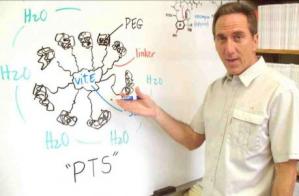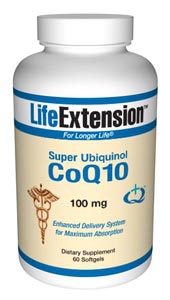 If U.C Santa Barbara Chemist Bruce Lipshutz has his way, you may soon be buying bottles of water brimming with the life-sustaining coenzyme CoQ10 at your local Costco.
If U.C Santa Barbara Chemist Bruce Lipshutz has his way, you may soon be buying bottles of water brimming with the life-sustaining coenzyme CoQ10 at your local Costco.
Never heard of CoQ10? Lipshutz says you’re not alone. “If you don’t know anything about it,” Lipshutz said during a recent interview, “that’s not surprising to me. Much of the public hasn’t heard of it.” But he’s on a mission to correct what he views as a major oversight. “In a sense, I’m just a messenger. People need to not only know about CoQ10, they need to take it.”
(Photo by Elan Sun Star)
Like vitamin C, CoQ10 (also known as ubiquinone, or coenzyme Q) is a compound that’s vital to our survival. It’s a coenzyme that our cells synthesize, albeit in 21 steps, and it’s in every cell.  This contrasts with a vitamin, such as vitamin C, which is not made by the body. Both CoQ10 and vitamin C are “compounds of evolution,” Lipshutz said. “Everybody accepts the importance of vitamin C. The reason the public does not fully appreciate it is that there’s no Linus Pauling for CoQ10. There is no champion.”
This contrasts with a vitamin, such as vitamin C, which is not made by the body. Both CoQ10 and vitamin C are “compounds of evolution,” Lipshutz said. “Everybody accepts the importance of vitamin C. The reason the public does not fully appreciate it is that there’s no Linus Pauling for CoQ10. There is no champion.”
Pauling, a Nobel Prize-winning scientist, was also an advocate for greater consumption of vitamin C. “CoQ is not really in that category of public awareness yet,” Lipshutz said.
While the body produces its own CoQ10, that production decreases with age. “Nature gave us, through 2.5 billion years of evolution, a number of fundamental anti-aging, free-radical scavengers that helped us to survive, on average, only to about 40 years of age, until modern medicine came along,” Lipshutz said.
A large percentage of the body is made up of water, “but there are also the lipophilic portions of our cells that make up the non-aqueous part,” Lipshutz explained. At some point in our evolution, the water-soluble antioxidant vitamin C was produced in vivo, or what would technically be “coenzyme C.” Eventually, “a mutation took place that now prevents humans from making it,” he said. “However, evolution chose not to mutate out CoQ10.”
If one doesn’t get vitamin C, the consequences can be dire. “It’s essential for several cellular processes. For example, everyone knows about scurvy,” Lipshutz said. “You can last 30 days, maybe 60 days, as your cells deteriorate.”
On the other hand, CoQ10 – much of which is in the mitochondria of our cells – is essential for cellular respiration and ATP (adenosine triphosphate) production. “You wouldn’t last 30 minutes without CoQ10,” he said. “Thus, evolution teaches us that CoQ10 is as important as vitamin C. But who’s teaching this to our aging population? Nobody.”
In an upcoming review, Lipshutz discusses how recent advances in chemistry can be used to solubilize otherwise naturally insoluble compounds like CoQ10 into water. He calls it green chemistry and it required him to “go nano”.
CoQ10 in Current Form is Inefficient
Lipshutz has a history of CoQ10 research at UCSB. Initially, he retooled the chemistry that would produce the supplement via synthesis instead of fermentation, which is how Japan became the world leader in CoQ10 production. But China’s entry into the CoQ10 market only a few years ago changed everything.

“The price of CoQ for over 30 years was about $1,600 per kilo as produced by the Japanese,” Lipshutz said. “The Chinese came along and, for the time being, have dramatically altered the market by deciding at the government level that they were going to own this important area of dietary supplements.”
CoQ10 now costs as little as $400 a kilo and is sold wherever you can buy vitamins — marketed as providing a boost in energy as well as a healthy heart and younger looking skin. However, the body can only absorb 10-15 percent of CoQ10 in the softgel form.
Lipshutz wanted to learn what else could be done with this life-enriching compound. How, he asked, could this become more available and bioefficient?
“The future is not about access to CoQ10 anymore,” he said. “It’s not about, ‘Do we have the best synthesis?’ or ‘Can we compete with the Chinese?’ It’s about getting it into water, so that we can get it into our mitochondria.”
Quite a challenge since CoQ10 is water insoluble. The answer? Go nano.
Going Green With Nano
It turns out that nanotechnology delivers twice the amount of the compound into the bloodstream. This new approach for adding nutrients into the body with water could be applied to a broad range of health supplements, including omega-3s, beta-carotene, and resveratrol. “We can also take pharmaceuticals, like Taxol, an anti-tumor agent, and put them into just water or saline using this PTS,” he said.
By taking advantage of this nano-micelle technology, synthetic chemistry can also be done inside the nano-containers. That translates into doing chemistry in pure water, and at room temperature. “That’s green chemistry,” Lipshutz said.
The amount of heat usually needed in reactions, and the waste created by organic solvents, are dramatically reduced. Lipshutz hopes that when his processes are looked at on a much larger scale, a savings of metric tons of solvent, currently released into the environment, will be realized.
“We aim to get organic solvents out of organic reactions,” he said. “And we’re already looking into next-generation possibilities. All of our green chemistry has come out of being able to put CoQ10 and other dietary supplements into water.”
Lipshutz sees this as his most significant contribution to an already illustrious career as an organic chemist.
“It’s an opportunity to affect every person on the planet,” he says proudly.
His review, “Transition Metal Catalyzed Cross-Couplings Going Green: in Water at Room Temperature,” will be published in Aldrichimica Acta in September. To learn more about the science, see the UC Santa Barbara release.




















I take COQ10 every day because I take Lipitor. My doctor was very happy that I do that and asked me how many miligrams I take each day. This is a wonderful breakthrough. I hope it comes to pass.